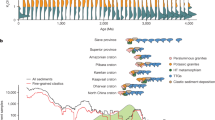Abstract
The discovery of layered sediments of the Elatina Formation of South Australia has attracted intense speculation regarding their origin1,2. The formation 10-m layer of graded sandstone, consists of a pattern of light bands of periodically varying thickness3. A sequence of dark bands separates, on average, 11.6 light bands; the spacing of these dark bands exhibits a rich and complex spectrum. Previously, the periodicity has been attributed to the sunspot cycle and unassigned but putative solar periods. Prompted by a letter from G. E. Williams, summarizing new field data from the Adelaide region, South Australia, which imply that the Elatina varves may be tidal, we re-examined the dark-band spectrum and propose a luni-solar tidal interaction model as the source of the laminae.
This is a preview of subscription content, access via your institution
Access options
Subscribe to this journal
Receive 51 print issues and online access
$199.00 per year
only $3.90 per issue
Buy this article
- Purchase on Springer Link
- Instant access to full article PDF
Prices may be subject to local taxes which are calculated during checkout
Similar content being viewed by others
References
Williams, G. E. Nature 291, 624–628 (1981).
Williams, G. E. Aust. J. Phys. 38, 1027–1043 (1985).
Finney, S. A., Williams, C. R. & Sonetl, C. P. Proc. 19th Lunar and Planetary Sci. Conf. 331–332 (Lunar & Planetary Inst., Houston, 1988).
Stacey, F. D. Physics of the Earth (Wiley, New York, 1977).
Defant, A. Physical Oceanography, Vol. 2 (Pergamon, Oxford, 1961).
Williams, G. E. Aust. J. Phys. 38, 1027–1043 (1985).
Prior, D. B., Bornhold, Brian D., Wiseman, W. J. Jr & Lower, D. R. Science 237, 1330–1333 (1987).
Sonett, C. P. & Williams, G. E. Sol. Phys. 110, 397–410 (1987).
Williams, G. E. & Sonett, C. P. Nature 318, 523–527 (1985).
Brouwer, D. & Clemence, G. M. Methods of Celestial Mechanics (Academic, New York, 1961).
Danby, J. M. A. Fundamentals of Celestial Mechanics (MacMillan, New York, 1962).
Newhall, X. X., Williams, J. G. & Dicke, J. O. in Rotation and Reference Frames for Geodesy and Geodynamics (eds Babcock, A. K. & Wilkins, G. A.) 159–164 (Reidel, Dordrecht, 1988).
Hansen, K. S. Rev. Geophys. Spa. Res. 20, 457–480 (1982).
Creer, K. M. in Growth Rhythms and The History of The Earth's Rotation (eds Rosenberg, G. D. & Runcorn, S. K.) 293–318 (Wiley, New York, 1975).
Muller, M. & Stephenson, F. R. in Growth Rhythms and The History of The Earth's Rotation (eds Rosenberg, G. D. & Runcorn, S. K.) 459–534 (Wiley, New York, 1975).
Calame, O. & Mulholland, J. D. in Tidal Friction and The Earth's Rotation (eds Brosche, P. & Sünderman, J.) 43–54 (Springer, Berlin, 1978).
Jeffreys, H. The Earth (Cambridge University Press, 1970).
Tarling, D. H. in Growth Rhythms and The History of The Earth's Rotation (eds Rosenberg, G. D. & Runcorn, S. K.) 397–426 (Wiley, New York, 1975).
Morrison, L. V. in Growth Rhythms and The History of The Earth's Rotation (eds Rosenberg, G. D. & Runcorn, S. K.) 445–458 (Wiley, New York, 1975).
Miller, G. R. J. geophys. Res. 485–489 (1966).
Smith, A. G. & Hallam, A. Nature 225, 139–144 (1970).
Author information
Authors and Affiliations
Rights and permissions
About this article
Cite this article
Sonett, C., Finney, S. & Williams, C. The lunar orbit in the late Precambrian and the Elatina sandstone laminae. Nature 335, 806–808 (1988). https://doi.org/10.1038/335806a0
Received:
Accepted:
Issue Date:
DOI: https://doi.org/10.1038/335806a0
This article is cited by
-
Significant high number commensurabilities in the main lunar problem II: The occurrence of Saros-like near periodicities
Celestial Mechanics & Dynamical Astronomy (1993)
-
The 22-year cycle of the sun
Astrophysics and Space Science (1992)
-
On the persistence of the 22 y solar cycle
Solar Physics (1990)
Comments
By submitting a comment you agree to abide by our Terms and Community Guidelines. If you find something abusive or that does not comply with our terms or guidelines please flag it as inappropriate.



